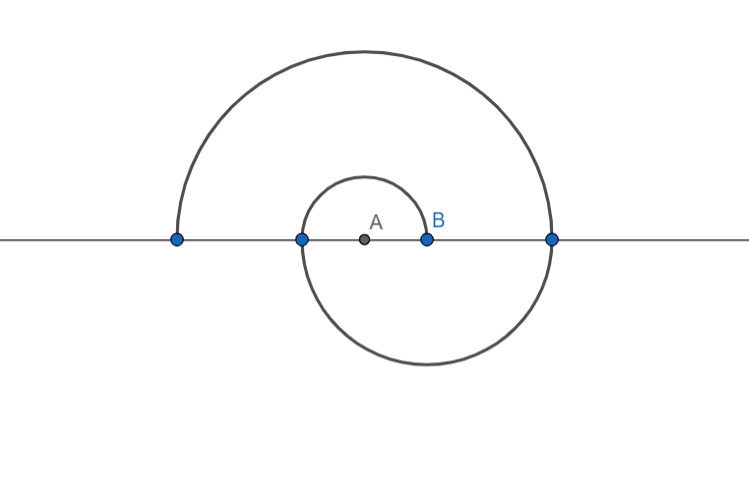
A spiral is made of successive semicircles with centres alternatively at A and B, starting with A, of radii 0.5cm, 1cm, 1.5cm, 2cm, … as shown in the figure below. What is the total length of the spiral consisting of 13 such spirals. Use $\pi =\dfrac{22}{7}$


Answer
513.6k+ views
Hint: Observe that the radii here are in A.P. Since circumference of cirlce $\propto r$,the lengths of semicircles will also be in A.P. Find the common difference and first term of that A.P. Use ${{S}_{n}}=\dfrac{n}{2}\left( 2a+\left( n-1 \right)d \right)$ for finding total length of the spiral.
Complete step-by-step answer:
We know that if $\left\{ {{a}_{n}} \right\}$ is an A.P with common difference d then $\left\{ k{{a}_{n}} \right\}$ is also an A.P with common difference kd.
Here Sequence of radii is 0.5cm, 1cm, 1.5cm, 2cm, … which is clearly an A.P with first term a = 0.5cm and common difference 1-0.5 =0.5cm.
Also Length of semicircle $=\pi r$
So the sequence of lengths of semicircles will also be an A.P with common difference $=0.5\pi cm$ and the first term will be $0.5\pi cm$.
Now we know that ${{S}_{n}}=\dfrac{n}{2}\left( 2a+\left( n-1 \right)d \right)$
Put n = 13, $a=0.5\pi cm$ and $d=0.5\pi cm$, we get
$\begin{align}
& {{S}_{13}}=\dfrac{13}{2}\left( 2\times 0.5\pi +\left( 13-1 \right)0.5\pi \right)cm \\
& =\dfrac{13}{2}\left( \pi +6\pi \right)cm \\
& =\dfrac{91}{2}\pi cm \\
\end{align}$
Substituting $\pi =\dfrac{22}{7}$, we get
\[{{S}_{13}}=\dfrac{91}{2}\times \dfrac{22}{7}=143cm\]
Since ${{S}_{n}}$ is the sum of lengths of first n spirals ${{S}_{13}}$ will be the total length of the spiral consisting of 13 consecutive semicircles.
Hence the total length of the spiral consisting of 13 such spirals is 143cm.
Note: [1] If $\left\{ {{a}_{n}} \right\}$ is an A.P with common difference d then $\left\{ k{{a}_{n}} \right\}$ is also an A.P with common difference kd. This statement can be proved with simple calculations:
$\left\{ {{a}_{n}} \right\}=\left\{ a,a+d,a+2d,...,a+\left( n-1 \right)d \right\}$
so $\left\{ k{{a}_{n}} \right\}=\left\{ ka,ka+kd,ka+2kd,...,ka+\left( n-1 \right)kd \right\}$
Hence the first term of the sequence $\left\{ k{{a}_{n}} \right\}$ is ka and the common difference is kd.
[2] If $\left\{ {{a}_{n}} \right\},\left\{ {{b}_{n}} \right\}$ are two A.Ps, then so is $\left\{ {{a}_{n}}+{{b}_{n}} \right\},\left\{ {{a}_{n}}+k \right\}$ and $\left\{ k{{a}_{n}} \right\}$
Complete step-by-step answer:
We know that if $\left\{ {{a}_{n}} \right\}$ is an A.P with common difference d then $\left\{ k{{a}_{n}} \right\}$ is also an A.P with common difference kd.
Here Sequence of radii is 0.5cm, 1cm, 1.5cm, 2cm, … which is clearly an A.P with first term a = 0.5cm and common difference 1-0.5 =0.5cm.
Also Length of semicircle $=\pi r$
So the sequence of lengths of semicircles will also be an A.P with common difference $=0.5\pi cm$ and the first term will be $0.5\pi cm$.
Now we know that ${{S}_{n}}=\dfrac{n}{2}\left( 2a+\left( n-1 \right)d \right)$
Put n = 13, $a=0.5\pi cm$ and $d=0.5\pi cm$, we get
$\begin{align}
& {{S}_{13}}=\dfrac{13}{2}\left( 2\times 0.5\pi +\left( 13-1 \right)0.5\pi \right)cm \\
& =\dfrac{13}{2}\left( \pi +6\pi \right)cm \\
& =\dfrac{91}{2}\pi cm \\
\end{align}$
Substituting $\pi =\dfrac{22}{7}$, we get
\[{{S}_{13}}=\dfrac{91}{2}\times \dfrac{22}{7}=143cm\]
Since ${{S}_{n}}$ is the sum of lengths of first n spirals ${{S}_{13}}$ will be the total length of the spiral consisting of 13 consecutive semicircles.
Hence the total length of the spiral consisting of 13 such spirals is 143cm.
Note: [1] If $\left\{ {{a}_{n}} \right\}$ is an A.P with common difference d then $\left\{ k{{a}_{n}} \right\}$ is also an A.P with common difference kd. This statement can be proved with simple calculations:
$\left\{ {{a}_{n}} \right\}=\left\{ a,a+d,a+2d,...,a+\left( n-1 \right)d \right\}$
so $\left\{ k{{a}_{n}} \right\}=\left\{ ka,ka+kd,ka+2kd,...,ka+\left( n-1 \right)kd \right\}$
Hence the first term of the sequence $\left\{ k{{a}_{n}} \right\}$ is ka and the common difference is kd.
[2] If $\left\{ {{a}_{n}} \right\},\left\{ {{b}_{n}} \right\}$ are two A.Ps, then so is $\left\{ {{a}_{n}}+{{b}_{n}} \right\},\left\{ {{a}_{n}}+k \right\}$ and $\left\{ k{{a}_{n}} \right\}$
Recently Updated Pages
What is the degree of the angle at 6 oclock-class-8-maths-CBSE

Bad effects of various festivals on the environment class 8 chemistry CBSE

How would you describe a globe class 8 physics CBSE

Whats the square root of 3721 class 8 maths CBSE

A container has a capacity of 300 litres If the liquid class 8 maths CBSE

A colour TV is available for Rs 13440 inclusive of class 8 maths CBSE

Trending doubts
For Frost what do fire and ice stand for Here are some class 10 english CBSE

What did the military generals do How did their attitude class 10 english CBSE

What did being free mean to Mandela as a boy and as class 10 english CBSE

What did Valli find about the bus journey How did she class 10 english CBSE

Can you say how 10th May is an Autumn day in South class 10 english CBSE

Explain the Treaty of Vienna of 1815 class 10 social science CBSE




